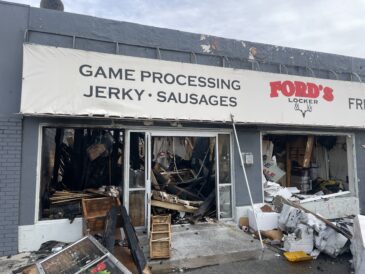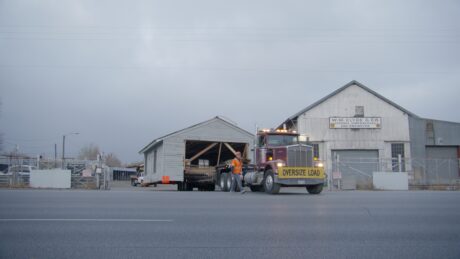Behind the scenes: City of Fun Carnival brings summer excitement to Utah County and beyond for 50+ years
A date, a night out with friends, family fun: These scenarios and many more attract attendees of all ages to carnivals. For as long as city celebrations have been held in Utah County, carnivals have helped play a part in bringing cross sections of the community together as a staple in summertime Americana.
According to the Outdoor Amusement Business Association, an estimated 500 million attendees visit carnivals, fairs and festivals across the United States annually.
However, behind the neon lights, alluring games and sweet-tooth-satiating food booths is a traveling group of people dedicated to a lifestyle of entertaining communities and long, hard work.
“It’s just all I’ve ever known,” said Pam Zoeller, general manager and vice president of City of Fun Carnival, based out of Pleasant Grove. “This job is not for everybody,” said Zoeller. “It’s a hard life to live, and it takes a special kind of person to do it.”
Zoeller, an American Fork resident who stands as the second of five generations working in the carnival’s 50-plus-year history, grew up learning the ropes of the industry working for her parents, Lou and Lois Melendez.
Lou Melendez, a World War II veteran, attended Ricks College (now Brigham Young University Idaho) and finished up his business degree at BYU’s Provo campus, where he met Lois Melendez. Lou Melendez got his start in the carnival industry when his standout application letter alone got him a job at the amusement park at New Jersey’s Seaside Heights (decades later made popular by the MTV reality television show “Jersey Shore”).
Zoeller recalled, “He and the owner really got along great.” The owner had invested a successful kiddie ride as a side project, and eventually handed the ride over to Lou Melendez. Lou Melendez invested in another kiddie ride as well. However, things changed when the owner died; he was fired and the owner’s son was put in Lou Melendez’s position. So, he was left with no job, two kiddie rides and a family with two children.
Zoeller explained that Lou and Lois Melendez then moved to Provo, Lois’ hometown, to start anew. “Both my mom and dad just worked and worked and worked until they got two little rides up to this mammoth thing we have now,” said Zoeller.
As Lou Melendez got older and less involved with the carnival, he and his daughter would joke in a kind hearted, tough-love fashion about what would happen when he died as they bounced from spot to spot.
“Well, it depends on the spot, Dad,” Zoeller recalled telling her father. “If it was a slow one, we could take care of you and have a funeral. If it’s a busy one, you’re going in the freezer until the end of the season,” she said with a smirk.
After Lou Melendez had stays in a veteran’s home and senior center, Zoeller got a call from her brother in 2011 while moving rides from an event during a relatively fruitless May. Lou Melendez had passed away.
“It was an empty week,” Zoeller said. “So, the whole crew could go. They all loved him, and I thought, ‘Well, OK Dad, you planned that one, didn’t you?'”
Today, Lois Melendez, 87, stands as the CEO of City of Fun Carnival and takes care of some office work, while her daughter, Zoeller, handles the bulk of the carnival’s logistical operations.
“I have to decide where we’re going to go, and I make the contracts for each individual town,” Zoeller said. “In a year, we only move about 7,000 miles. We just cover Utah, Arizona and a little bit of Idaho and New Mexico.”
The carnival typically begins in March in Parker, Arizona, and ends around Thanksgiving wherever the fall takes them. Winter months are often spent scheduling spots and doing heavy maintenance and overhauls on rides.
Land and a source of water are the two main commodities events provide the carnival, and City of Fun provides the rest, explained Zoeller. “People don’t understand the area and all the resources one needs to effectively and safely run rides.”
Generators to produce mass amounts of electricity, specialty driver’s licenses to tow rides and additional endorsements to haul the generators, required mobile housing for workers, and a tightly-tuned route schedule up to five years in advance are a few of the things running through Zoeller’s mind daily.
Weather is an unpredictable aspect that directly affects the carnival’s financial bottom line, and one that can produce some scorned guests.
“Most people think the carnival just comes in and makes money and takes it all away with them,” Zoeller said. “We pay the city, committee, or whoever’s in charge a certain amount to rent the land. So, when it does rain, we’re the ones that take the chance whether we’re going to make any money or not. Whoever we’re doing the celebration with, they always get paid. We don’t always end up at the end of the week with money.”
The carnival is full of family, both literal and honorary.
Of the approximately 65 employees, 10 are directly related to her, spanning from her mother to her granddaughters. Her brother, Brad Melendez Sr., is the carnival’s president. Midway manager Frank Morales, related to Pam by marriage, has a few family members and their relatives involved with the carnival himself. Morales, now in his 40s, began working for Lou and Lois Melendez and the carnival at the age of 14.
City of Fun Carnival owns 22 rides. A Native American firm from Canada called the Dream Catcher Café runs the food services at the carnival. The games at the carnival are owned by outside individuals who contract with the carnival.
“My midway manager and this crew that we have here can get this all down, loaded on the trucks and ready to pull out in about five hours,” said Zoeller. She explained that rides can cost her anywhere from $200,000 to $900,000 for a single attraction.
Teardown days are the longest days for employees.
City of Fun typically moves into an area on a Monday, and sets up rides and conducts thorough safely inspections before opening around noon on Wednesday. However, there’s variance on the days and times from spot to spot. Saturdays are usually the last night of operations, and the carnival does safety inspections before opening at noon, and stays open until whenever the event ends, sometimes as late as midnight.
Upon closing on teardown days, employees then spend til about 5 a.m. tearing down rides then transporting everything back to a storage yard in Lindon before the sun rises.
In overnight-hop situations, employees begin work around noon, teardown from midnight until about 5 a.m., and then go to a new spot to then begin setting up the carnival once again for another event.
“That’s what you do in this business,” Zoeller said. “You make a commitment to an event and you’ve got to be there. But, they all kind of even themselves out. One week you get a lot of rest, and the next week there’s no rest.”
Burnout can be a serious issue in the carnival industry. Zoeller pays her employees after teardown from each event, and explained, “When you get to the next spot, you don’t know if anyone’s going to show up or not.” Fortunately, she said that retention has been a minimal issue for the City of Fun.
Crucial to keep the carnival running is the H-2B Program, which sends Zoeller about 25 workers from Mexico each year. H-2B is a federal program that allows employers to temporarily hire non-immigrants to do non-agricultural labor or services in the United States, as stated by the U.S. Department of Labor.
“They’re really awesome workers,” said Zoeller. “They don’t complain, they don’t have bad habits, and they’re all polite and clean. They’re my highest paid people out here,” she said.
Gaspar Gutierrez, a 41-year-old man from Agua Prieta, Sonora, Mexico, has been working through the H-2B program for 13 years, and spent every year with City of Fun Carnival. “I get to learn different things every day,” he said.
Zoeller described Gutierrez as her “go-to man” for electrical repairs. Gutierrez said he starts his shifts inspecting rides, and the rest of it maintaining equipment and controlling the crowds. Besides frequent energy drinks to keep him alert during long hours, he said that, “providing for my family keeps me going.” He is married with five children.
“He spends some of his money each year on equipment or tools of some kind, to take back to Mexico and make a better life there for his family,” Zoeller said. “It’s hard to be away from them for months at a time.”
Through all the hard work, there have been spots of fame for City of Fun Carnival.
City of Fun was featured in the carnival scene of the 1993 coming-of-age comedy film, “The Sandlot.” The carnival scene was filmed in American Fork, and other Utah locations were featured as well. “City of Fun” can be seen on the ticket booth as the carnival scene opens.
“We had to have everyone dress in 1950s clothes,” she said. According to Zoeller, filming took place the night before they opened in American Fork, and persisted until nearly 4 a.m. “Those were bratty little kids,” joked Zoeller of the cast of children, “and their mothers were even worse.”
However, young people, such as Zoeller’s granddaughter, Jayde Briones, may be crucial in the carnival’s future.
“When I finally got tall enough to reach the drink machine in the cotton-candy wagon, that’s pretty much when I started working,” said the 16-year-old.
“It was always fun growing up as a kid, riding rides and stuff,” she said. “But as I got older, I got more into getting to know the workers, and it’s more like a family out here. I mean, we’re not a normal family, but that’s the whole fun part of it.”







































